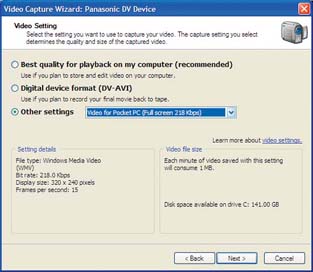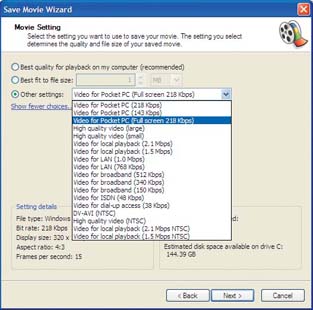Hack 88. Play Your Video on a Pocket PC
| < Day Day Up > |
|
If you own a Pocket PC computer, whether it's a cell phone or an organizer, you can carry and play your videos anywhere. The Pocket PC platform can be found in personal digital assistants (PDAs), cell phones, and palmtop computers. It's a versatile system that is capable of working with Microsoft Excel and Word documents, dealing with email, and browsing the Web. It can also play a movie, if it's encoded properly. The easiest way to encode for a Pocket PC is to use Windows Movie Maker. 7.14.1. Capturing Your FootageThere are two methods of creating a movie that can play on a Pocket PC, and which method you use will depend on what stage in the editing process you decide to create such a movie. If you are just starting your project and know that you will only be delivering your project to a Pocket PC device, you can select one of the Pocket PC profiles when you start capturing your footage. Figure 7-51 shows the Capture dialog box for Windows Movie Maker with the Pocket PC profile selected. If you will be targeting other media, such as videotape, DVDs [Hack #79], or the Web [Hack #82], capture your footage at the highest resolution possible (for example, DV-AVI). By doing so, you will be able to down-convert your footage from its original form to a form of lesser quality. This is important, because if you try to up-convertyour footage, from a form of lesser quality to one of higher quality, you will get disappointing results. Figure 7-51. Pocket PC profile selected
After you have captured and edited your footage, you need to export it. 7.14.2. Exporting for Pocket PCFrom the main window of Movie Maker, choose Finish Movie One the other hand, if you've captured your footage at a higher quality, such as DV-AVI, you need to click the "Show more choices…" button and then select the "Other settings:" radio button. By doing so, you enable the drop-down list where you can select a profile. As a default, there are three Pocket PC options, so you should select the one that best fits your needs. Figure 7-52 shows the "Video for Pocket PC (Full screen 218Kbps)" profile selected. Figure 7-52. Exporting a Pocket PC video After selecting your profile (if appropriate) and clicking the Next button, Movie Maker handles the details for you and begins processing your final movie. When it is complete, you have the option to immediately open thevideo in Windows Media Player, to ensure the quality is sufficient for you. If it isn't, you will need to go back and try one of the different Pocket PC profiles. 7.14.3. Selecting a Codec and File FormatIf you don't have Windows Movie Maker, then you need to transcode your video [Hack #29] into a format that your Pocket PC can play. The standard Pocket PC distribution includes Windows Media Player, which can play practically any .wmv file.
Transferring Your Video File There are two primary ways to get a video file onto your device. The first is to use ActiveSync, which should have been included with your device. If it wasn't, then you can obtain it directly from Microsoft's Windows Mobile download site at http://www.microsoft.com/windowsmobile/downloads/default. mspx. The other way is to transfer the video to your device is to use a memory card. By using a memory card reader, you will be able to copy the video directly to the card and then insert it into your device. The advantage to this approach is that it is much faster than using ActiveSync, especially for large files. So, if you have that masterpiece you've always wanted to show Spielberg, you can throw it on your Pocket PC…and should you ever meet him, you'll be prepared. |
| < Day Day Up > |
EAN: 2147483647
Pages: 158

 "Save to my computer." This will bring up a dialog box asking you to name your exported movie, as well as to select a location on your hard disk to save it. After providing the information, and clicking the Next button, you will have the opportunity to select the profile for saving your movie. If you initially captured your footage using the Pocket PC profile, you can keep the default setting and click the Next button.
"Save to my computer." This will bring up a dialog box asking you to name your exported movie, as well as to select a location on your hard disk to save it. After providing the information, and clicking the Next button, you will have the opportunity to select the profile for saving your movie. If you initially captured your footage using the Pocket PC profile, you can keep the default setting and click the Next button.